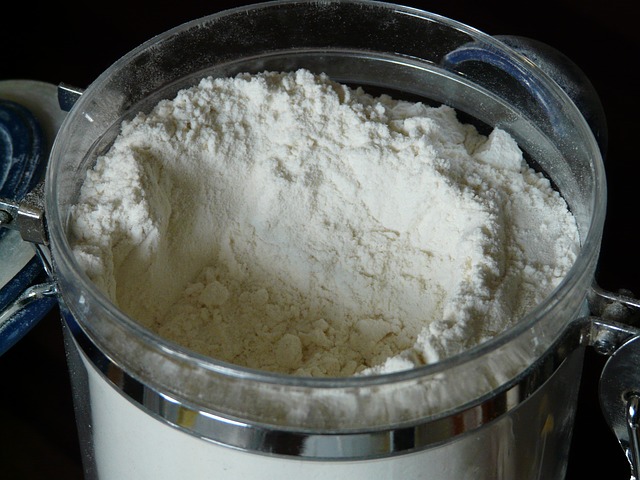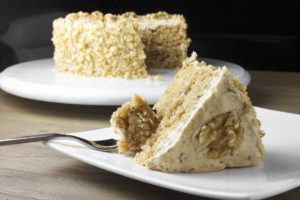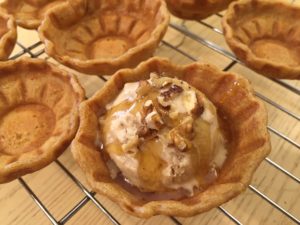HOW TO MAKE YOUR OWN GLUTEN-FREE
ALL-PURPOSE FLOUR BLEND
Where “all-purpose gluten-free flour” is called for in
a recipe, this is my blend that works successfully.
This Oat flour blend is far healthier than any
packaged gluten-free flour blend I’ve seen. It’s a
slower burning, nutrient dense source of carbohydrates.
It means you feel full longer, and it doesn’t spike your
sugar, a trigger for insulin resistance and diabetes.
This gluten-free flour blend will save you money.
Compared to buying mixes, it’s healthier than any other
gluten-free flour options because both oat flour and tapioca
are not just delicious, and readily available, they’re listed
in the ten approved carbs for diabetics!
Oat flour is more cost-effective, than almond or nut flour
and makes lighter baked goods. I did not enjoy baked
goods made from coconut flour. They had a distinct
unpleasant dryness. The lack of moisture requires recipes
specific to coconut flour that require a lot more moisture.
So it is not versatile.
You can buy oat flour (From Amazon or Whole Foods,
or Bob’s Red Mill), or you can grind whole or instant oats
into flour yourself in a processor or coffee grinder and
sift in a mesh strainer. Discard any hard particles. Then
measure oat flour after sifting. It only takes 5 minutes,
and you’ll save a ton of money and inconvenience.
If you can’t buy oat flour, you simply need an
inexpensive coffee grinder or food processor. Organic
Instant oats are best. (Not the flavored ones sold in
individual paper packets). They’re just smaller and
thinner than traditional old-fashioned rolled oats.
They can be finely ground faster than whole oats.
They have the same exact health benefits as
old-fashioned oats, but instant oats are smaller,
and thinner, so they soften faster…They yield
really soft and tender healthy baked goods!
Tip: You can usually find them right next to the
old-fashioned rolled oats at the grocery store, and
instant oats are also perfect for making oatmeal
cookies! (You can use them to make ALL of these
healthy and yummy recipes of mine!)
I store this flour on my counter in a large stainless steel
canister (from Costco). Do not refrigerate oats unless
you’ll be storing them, airtight, for months. Excess
moisture from condensation may cause it to spoil.
Use this gluten-free all-purpose flour blend,
swapped out 1 for 1, in any of your favorite
GF recipes!
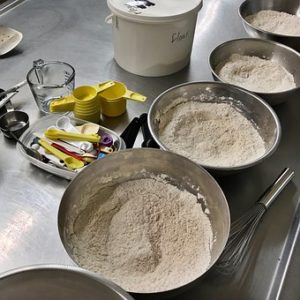
++++++++++++++++++
For every 1 cup of GF flour (called for in a recipe) use:
3/4 cup oat flour + 1/4 cup tapioca (starch/flour)
1/2 tsp. xanthan gum (optional, but helps it bind fluffy
baked goods that may otherwise fall apart when sliced).
++++++++++++++++++
These blends can be bottled to have on hand.
To make ready-ground bagged Flour
whisk these Ingredients:
TWO 16-ounce bags of oat flour (10 cups),
16 oz. Tapioca
Using Arrowhead Mills 18 oz bag of tapioca starch:
Use ONE 18 oz bag MINUS 1/4 cup, (4 tbs. or 2 ounces)
(Remove and save the tapioca starch
from the 18 oz. bag for future use).
1/4 tsp. xanthan gum (or ground flaxseed) per cup of flour
blend, in a gluten free recipe (optional, but helps it bind)
Try to measure carefully. It’s OK to err with a wee bit
too much flour, but never with too much tapioca!
Store in an airtight container up to several weeks
below 80º-Fahrenheit.
I keep this blend in a large stainless steel airtight
canister.
Do not refrigerate oats unless you’ll be storing
them, airtight, for months.
Fluffy Gluten-free breads and cakes tend to fall
apart without a form of stabilizer to replace the
missing gluten. (Not as much is needed for cookies
or muffins.)
If you can’t use xanthan gum,
For every Tsp. of xanthan in the recipe use:
2 parts hot water and 1 part flax.
*ground flaxseed or chia seed. Let it gel in 2 tbs. hot
water for a few minutes. (this helps bind fluffy bread
and cake) not required for cookies.
*If you don’t have any xanthan gum, or don’t like
using it, try replacing it with: 1/3 cup of ground chia
seeds or ground flax seeds 1:1 ratio, mixed with 2 parts
hot water for every 1 part flax and let it gel for 5 minutes.
It will work just like Xanthan gum.
Replacements may not give exactly the texture and qualities
to some recipes that you might expect. You may need to
experiment with the replacement ratio a bit or bake a bit longer.
What’s more, these seeds pack lots of fiber and important
nutrients. While you can use chia seeds whole, they add a bit
of crunch and mild, nutty flavor to your recipe — so you should
grind them if you prefer a smoother texture.
Ground Chia seeds can replace xanthan gum.
Add 2 parts of hot water for every 1 part of chia seeds,
then stir until the mixture becomes viscous.
To have your own all-purpose GF blend always on hand,
you need only 2 ingredients, plus a “stabilizer,” (which I prefer
xanthan or guar gum because it’s plant-based, easy to buy and
use, and it holds fluffy baked goods together).
You can alternatively use,
flax seed or chia seed egg
I often buy Arrowhead Mills ready-made organic
oat flour, six bags at a time, on Amazon.
Other times, I grind organic quick or whole oats,
a batch at a time in my coffee grinder, when
I can’t get it on Amazon.

I’ve been bottling and using this blend
successfully for all my gluten free recipes,
except for those that call for Almond flour
which is a different flavor and texture.
(1¾ cups of whole oats, should yield 1½
cups (or more) of oat flour once it is ground
and sifted and hard kernels tossed out).
Instructions
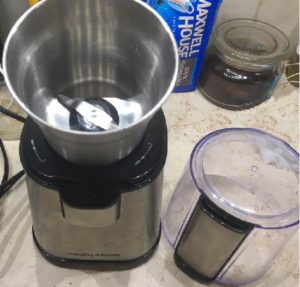
Put 1¾ cups of oats in your coffee grinder or
food processor. your coffee grinder may hold
only 1/2 a cup at a time.
Grind down until the oats are the texture of flour.
(This will take about 1/2 a minute depending on
the power of your blender).
Pour the oat flour into a wire mesh strainer or a
flour sifter and sift over a large bowl to take out
larger flakes of bran. (Save any large bits of bran
for another recipe, such as oatmeal cookies).
Cake and buns need flour to be a fine texture.
1½ cup of oat flour Measure out and put it into a
bowl. (This should be what you have left after
sifting out 1 to 2 tbs. of bran).
Add the tapioca flour and xanthan gum to the oat
flour and stir well until it is well mixed.
Store in an airtight container in the fridge until you
are ready to use it in any baked goods.
Recipe Notes
Why use organic oat flour instead of other
gluten-free flour choices?
Oats have a similar protein content to that of wheat
flour, so it bakes up like wheat flour in most recipes.
It’s inexpensive and easy to find. You can grind oats
fresh, so they will maintain more nutrients than pre-milled
packaged flour. It’s healthier than many other gluten-free
flour choices. It uses the whole grain unlike white rice
flour or other mixes.
You can choose not to sift it and have a whole wheat
style texture.
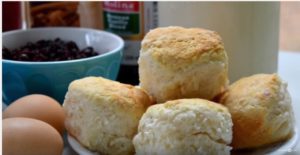 What else can I make with
What else can I make with
this gluten-free flour mix?
Any of your favorite recipes
with this gluten-free flour mix
swapped out 1 for 1! You can
also easily convert this recipe into Homemade
Gluten Free Bisquick and make these amazing gluten-free
Vegan ‘Red Lobster’ Cheddar Bay Biscuits!
Gluten Free Flour Recipe
An all-purpose gluten-free flour mix that you can
use 1:1 instead of wheat flour in all of your baking.
Author: (https://draxe.com/)
Author: Monica – Veggies (https://thehiddenveggies.com/)
Oat Substitutes
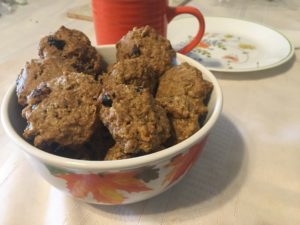
You can replace the oats in an oatmeal
cookie recipe with an equal amount of ground
flaxseed, quinoa flakes or chia seeds.
Ground flaxseed has very little flavor and is likely to
produce cookies that taste similar to the recipe
with oats, with a slightly denser texture.
Quinoa flakes have a slightly nutty flavor that can
enhance the natural sweetness of oatmeal cookies
and give them a similar texture to oats. Chia seeds
have a hardly-noticeable nutty flavor and create a
more crumbly oatmeal cookie unless you add a tsp of
xanthan gum.
If you like the taste and texture of whole wheat.
simply omit the sifting step when making this flour,
leaving the bran in. It will leave more texture and a slightly
nuttier taste similar to whole wheat.
You want to make sure to measure out exactly 1-1/2 cups
of sifted oat flour for the mix. Make sure to tap the measuring
cup a few times to settle the flour when measuring or measure
the flour by weight.
Starting with 1-3/4 cups of whole oats, it should yield 1-1/2
cups of oat flour once it is ground and sifted.
*Xanthan gum is optional, but it will help your baked goods
hold together a little better and not crumble.
Put gluten-free whole oats into a food processor or coffee
grinder. Blend for about 1 minute until the oats have turned
into flour.
Pour into a wire mesh strainer or a flour sifter and sift over
a large bowl until all the fine flour has fallen through and
throw away the large bran that is left in the strainer.
Add tapioca flour (aka tapioca starch) and xanthan gum to
the bowl of oat flour and mix with a whisk or fork.
A series of 3 pictures showing the steps of adding the tapioca
flour and xanthan gum to the oat flour to make a gluten free
flour recipe.
Store in a sealed container in the fridge until you are ready
to use it in your next recipe.
How to measure this gluten-free flour…
Since this flour is made fresh and sifted, it tends to be fluffy
and has to be measured differently to get the same results
as wheat flour.
When you measure it by volume, tap the measuring cup on
the counter top a few times to settle the flour and then add
more until the measuring cup is full to the top.
Your measurement will be most accurate by weight. One cup
of wheat flour weighs 4.5 oz or 120 grams, so make sure your
gluten-free flour weights the same as wheat flour when swapping
it out in a recipe.
If you buy oat flour instead of grinding and sifting it yourself, it
tends to weigh the same as wheat flour and can be swapped
out 1:1.
You can easily grind Whole oats yourself in any basic
food processor. I prefer a $15 coffee grinder I bought on
Amazon.
Tapioca flour – helps the flour bind together.
With only oat flour, it gets very crumbly. Xanthan gum –
Works as an extra binder to hold your baked goods together.
Why this gluten-free flour recipe works …It works as a
replacement for wheat flour in almost any recipe. It’s made
from whole grain oats. You can easily grind your own oat
flour in seconds with your blender. Fresh ground flours
have more nutrients than store bought.
Read more about it here. Oat flour has many health benefits.
See what Dr. Axe (https://draxe.com/) has to say about it.
What equipment do I need to make my own oat flour?
A blender to grind the oats, A wire mesh strainer or a flour
sifter to sift out the larger pieces of bran that are left over.
Note: If the baked good recipe calls for egg or an egg substitute,
I have found that using a flax egg also give it more of the
whole wheat taste and texture.


